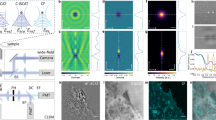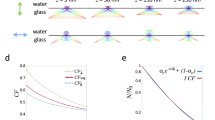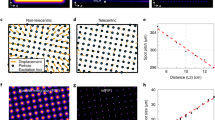Abstract
Emerging questions in cell biology necessitate nanoscale imaging in live cells. Here we present scanning angle interference microscopy, which is capable of localizing fluorescent objects with nanoscale precision along the optical axis in motile cellular structures. We use this approach to resolve nanotopographical features of the cell membrane and cytoskeleton as well as the temporal evolution, three-dimensional architecture and nanoscale dynamics of focal adhesion complexes.
This is a preview of subscription content, access via your institution
Access options
Subscribe to this journal
Receive 12 print issues and online access
$259.00 per year
only $21.58 per issue
Buy this article
- Purchase on Springer Link
- Instant access to full article PDF
Prices may be subject to local taxes which are calculated during checkout



Similar content being viewed by others
References
Huang, B., Babcock, H. & Zhuang, X.W. Cell 143, 1047–1058 (2010).
Shtengel, G. et al. Proc. Natl. Acad. Sci. USA 106, 3125–3130 (2009).
DuFort, C.C., Paszek, M.J. & Weaver, V.M. Nat. Rev. Mol. Cell Biol. 12, 308–319 (2011).
Moore, S.W., Roca-Cusachs, P. & Sheetz, M.P. Dev. Cell 19, 194–206 (2010).
Parsons, J.T., Horwitz, A.R. & Schwartz, M.A. Nat. Rev. Mol. Cell Biol. 11, 633–643 (2010).
Lambacher, A. & Fromherz, P. J. Opt. Soc. Am. B 19, 1435–1453 (2002).
Ajo-Franklin, C.M., Ganesan, P.V. & Boxer, S.G. Biophys. J. 89, 2759–2769 (2005).
Kanchanawong, P. et al. Nature 468, 580–584 (2010).
Xu, K., Babcock, H.P. & Zhuang, X. Nat. Methods 9, 185–188 (2012).
Gossen, M. & Bujard, H. Proc. Natl. Acad. Sci. USA 89, 5547–5551 (1992).
Burnette, D.T. et al. Nat. Cell Biol. 13, 371–381 (2011).
Barde, I., Salmon, P. & Trono, D. Curr. Prot. Neurosci. 53, 4.21.1–4.21.23 (2010).
Drees, F., Reilein, A. & Nelson, W.J. Methods Mol. Biol. 294, 303–320 (2005).
Lambacher, A. & Fromherz, P. Appl. Phys. A 63, 207–216 (1996).
Acknowledgements
We thank J. Lakins for guidance on the construction of talin fusion constructs, T. Onuta for assistance with the fabrication of silicon wafers at the Maryland Nanocenter FabLab, D. Trono (École Polytechnique Fédérale de Lausanne) for the gift of second-generation lentiviral vectors, W. Hillen and H. Bujard (University of Heidelberg) for the gift of the rtTAs-M2 construct and M. Krummel and S. Peck for helpful discussions. Images for this study were acquired at the Nikon Imaging Center at the University of California–San Francisco. This work was supported by the Breast Cancer Research Program Department of Defense Era of Hope grant W81XWH-05-1-0330, US National Institutes of Health (NIH)/National Cancer Institute (NCI) grant 1U54CA163155-01, NCI grant U54CA143836-01 and NIH/NCI R01 CA138818-01A1.
Author information
Authors and Affiliations
Contributions
M.J.P. and V.M.W. conceived and initiated the project. M.J.P. and K.S.T. designed the instrumentation. M.J.P., C.C.D. and M.G.R. designed and performed experiments. M.W.D. designed fluorescent protein constructs. M.J.P. and M.G.R. wrote the analysis software. V.M.W. and J.T.L. supervised the project. All authors wrote the paper.
Corresponding author
Ethics declarations
Competing interests
The authors declare no competing financial interests.
Supplementary information
Supplementary Text and Figures
Supplementary Figures 1–13 and Supplementary Note (PDF 3005 kb)
Supplementary Video 1
Paxillin and vinculin heights in adhesion complexes of migrating cells. Epifluorescence images (top) and SAIM 3D reconstructions (bottom) of paxillin-mEmerald and vinculin-mCherry in migrating epithelial cells. (AVI 6375 kb)
Rights and permissions
About this article
Cite this article
Paszek, M., DuFort, C., Rubashkin, M. et al. Scanning angle interference microscopy reveals cell dynamics at the nanoscale. Nat Methods 9, 825–827 (2012). https://doi.org/10.1038/nmeth.2077
Received:
Accepted:
Published:
Issue Date:
DOI: https://doi.org/10.1038/nmeth.2077
This article is cited by
-
Immunoengineering can overcome the glycocalyx armour of cancer cells
Nature Materials (2024)
-
Molecular mechanism of GPCR spatial organization at the plasma membrane
Nature Chemical Biology (2024)
-
Organization, dynamics and mechanoregulation of integrin-mediated cell–ECM adhesions
Nature Reviews Molecular Cell Biology (2023)
-
Polarization-sensitive intensity diffraction tomography
Light: Science & Applications (2023)
-
MAxSIM: multi-angle-crossing structured illumination microscopy with height-controlled mirror for 3D topological mapping of live cells
Communications Biology (2023)



